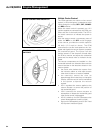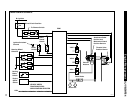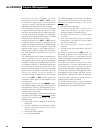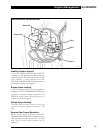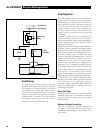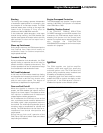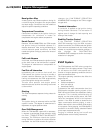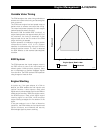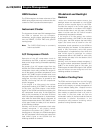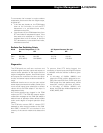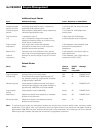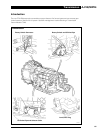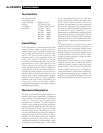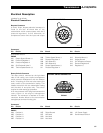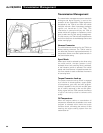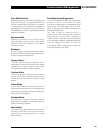
AJ-V8/5HP24
62
Engine Management
H02S Heaters
The ECM energizes the heater elements of the
HO2S during engine warm-up to shorten the time
it takes for them to produce accurate outputs.
Instrument Cluster
The instrument cluster uses CAN messages from
the ECM to operate the trip computer,
tachometer, engine coolant temperature gauge
and the BRAKE, CHECK ENG and general
warning lamps.
Note: The CHECK ENG lamp is commonly
known as the MIL.
A/C Compressor Clutch
Operation of the A/C compressor clutch is
controlled by the ECM, to prevent unnecessary
loads on the engine during unfavorable operating
conditions.
On receipt of an A/C request signal from the
A/CCM, the ECM immediately energizes the A/C
compressor clutch relay provided the engine is
not at idle speed, the coolant temperature is not
above 119˚C (246˚F) and the throttle valve is not
fully open. When the A/C compressor clutch relay
energizes, the relay output is sensed by the
A/CCM, confirming that the A/C compressor
clutch is engaged.
If the engine is at idle speed, the coolant
temperature is above 119˚C (246˚F) or the throttle
is fully open, the ECM outputs a load inhibit
signal to the A/CCM and delays energising the
A/C compressor clutch relay. At idle speed the
delay is only momentary (in the order of 50 ms)
while idle speed compensation is implemented,
after which the load inhibit signal is removed. At
coolant temperatures above 119˚C (246˚F) or with
a fully open throttle, the delay is for the duration
of the inhibiting condition.
Similarly, with the A/C compressor clutch relay
already energized, if the engine coolant
temperature exceeds 119˚C (246˚F) or the
throttle goes to fully open, the ECM de-energizes
the A/C compressor clutch relay and outputs the
load inhibit signal to the A/CCM until the
inhibiting condition is removed.
When the windshield heaters and/or the
backlight heater are requested on, the A/CCM
sends a screen request signal to the ECM.
Provided the engine is not at idle speed, the
coolant temperature is not above 119˚C (246˚F)
and the throttle valve is not fully open, the ECM
takes no action and the A/C control module
subsequently energizes the heaters.
If the engine is at idle speed, the coolant
temperature is above 119˚C (246˚F) or the throttle
is fully open, the ECM outputs the load inhibit
signal (the same one as used for the A/C
compressor clutch operation) to the A/CCM to
delay energising the heaters. At idle speed the
delay is only momentary while idle speed
compensation is implemented, after which the
load inhibit signal is removed. At coolant
temperatures above 119˚C (246˚F) or with a fully
open throttle, the delay is for the duration of the
inhibiting condition.
Similarly, with the heaters already energized, if
the engine coolant temperature exceeds 119˚C
(246˚F) or the throttle goes to fully open, the
ECM outputs the load inhibit signal to the A/CCM
and the heaters are de-energized until the
inhibiting condition is removed.
Radiator Cooling Fans
The ECM monitors inputs from the A/C single
and triple pressure switches, and from the ECT
sensor on the engine, to control the operation of
the two radiator cooling fans. Outputs from the
ECM control two relays contained in the radiator
fans module, to operate the fans in off, slow or
fast mode. In the slow mode the fans are
connected in series; in the fast mode the fans are
connected in parallel. Hysteresis in the
temperature and pressure switching values
prevents "hunting" between modes.
Windshield and Backlight
Heaters



